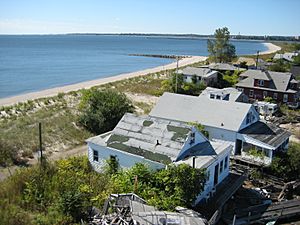List of ghost towns in Connecticut facts for kids
A ghost town is a place where most people have left, leaving behind empty buildings and a quiet, sometimes eerie, atmosphere. Connecticut, like many other states, has its own share of these forgotten places.

What is a Ghost Town?
A ghost town is a town, village, or city that has been mostly or completely abandoned. These places are often left with empty buildings and streets. They can feel very quiet and sometimes a little spooky. It's like time stopped there a long time ago.
Why Towns Become Empty
Towns become ghost towns for many reasons. Often, the main reason people lived there disappears. For example, a town might have grown because of a busy mine. When the mine closed, people moved away to find work.
Other reasons include:
- Natural Disasters: Floods, fires, or droughts can make a town unlivable.
- Economic Changes: A factory might close, or a new road might bypass a town. This can make it hard for businesses to survive.
- Resource Depletion: If a town depended on a specific resource, like timber or gold, it might be abandoned when that resource runs out.
- New Technologies: Sometimes, new ways of doing things make old towns unnecessary.
Ghost Towns in Connecticut
Connecticut has several places that are now considered ghost towns or once were. These towns tell stories of the past. They show how communities can change over time. Some of these places are now state parks or protected areas. This means you can visit them and explore their history.
Some notable ghost towns or former settlements in Connecticut include:
- Bara-Hack: Located in Windham County, this area has a long history.
- Dudleytown: Found in Litchfield County, it's known for its mysterious stories.
- Gay City: Now a State Park in Tolland County, it was once a busy mill village.
- Johnsonville Village: This village in Middlesex County was once a thriving mill community.
- Pleasure Beach: In Fairfield County, this was once a popular amusement park. It is now abandoned and mostly empty.
These places offer a glimpse into Connecticut's past. They remind us that even towns can have a life cycle, growing and shrinking over the years.

